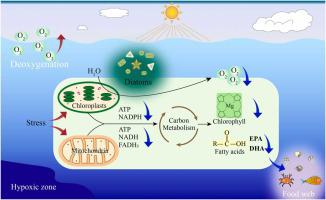当前位置:
X-MOL 学术
›
Environ. Exp. Bot.
›
论文详情
Our official English website, www.x-mol.net, welcomes your feedback! (Note: you will need to create a separate account there.)
Decreasing available O2 interacts with light to alter the growth and fatty acid content in a marine diatom
Environmental and Experimental Botany ( IF 5.7 ) Pub Date : 2024-02-02 , DOI: 10.1016/j.envexpbot.2024.105667 Bokun Chen , Jihua Liu , Hui Song , Ge Xu , Wei Zhao , Gang Li
Environmental and Experimental Botany ( IF 5.7 ) Pub Date : 2024-02-02 , DOI: 10.1016/j.envexpbot.2024.105667 Bokun Chen , Jihua Liu , Hui Song , Ge Xu , Wei Zhao , Gang Li

|
Hypoxic zones and oceanic deoxygenation are spreading worldwide due to anthropogenic activities and climate change, greatly affecting marine organisms exposed to lowered O. Yet, the effects of the lowered O on phytoplankton are often neglected when studying O effects as they are the O producers. Here we showed that low O (dissolved O, 150 ± 10 μmol L) enhanced the growth of the marine diatom in limited light but reduced it in moderate to inhibitory light and that hypoxia (40 ± 7.5 μmol L) reduced its growth at any growth lights. Low O and hypoxia decreased cellular chlorophyll and carotenoid content under growth light from 30 to 400 µmol photons m s, as well as photosynthetic efficiency (F/F). Such a decrease effect by low O or hypoxia also occurred in the O production by photosynthesis and the O consumption by dark respiration, especially under moderate to inhibitory growth light. Malondialdehyde, a product of lipid peroxidation, increased by up to 200% under low O, and by 400% under hypoxia at the highest light. The lowered O mechanistically down-regulated the expression of proteins related to chlorophyll synthesis, light energy conversion and transfer, and carbon metabolism. In addition, we found that the lowered O generally decreased the fatty acid content by more than 30%, along with the down-regulation of proteins related to the synthesis of these fatty acids and the elongation and desaturation of carbon chains. This suggests the change in the nutrition of marine grazers’ food and thus the potential impacts on the food chains in increasingly deoxygenated/hypoxic coastal waters.
中文翻译:

减少可用氧气与光相互作用,改变海洋硅藻的生长和脂肪酸含量
由于人类活动和气候变化,缺氧区和海洋脱氧现象在全球范围内蔓延,极大地影响了暴露于氧气含量降低的海洋生物。然而,在研究氧气效应时,浮游植物往往被忽视,因为浮游植物是氧气生产者。在这里,我们表明,低氧(溶解氧,150±10μmol·L)在有限的光照下增强了海洋硅藻的生长,但在中等至抑制性光照下减少了其生长,并且缺氧(40±7.5μmol·L)在任何生长条件下都会降低其生长灯。低氧气和缺氧会降低生长光下细胞叶绿素和类胡萝卜素的含量(从 30 µmol 光子 ms 降至 400 µmol 光子 ms)以及光合效率 (F/F)。低氧气或缺氧造成的这种减少效应也发生在光合作用产生的氧气和暗呼吸消耗的氧气中,特别是在中等至抑制性生长光下。丙二醛是脂质过氧化的产物,在低 O 条件下增加高达 200%,在最高光缺氧条件下增加 400%。降低的 O 会机械地下调与叶绿素合成、光能转换和转移以及碳代谢相关的蛋白质的表达。此外,我们发现,O的降低通常会使脂肪酸含量降低30%以上,同时与这些脂肪酸合成相关的蛋白质以及碳链的伸长和去饱和也会下调。这表明海洋食草动物食物的营养发生了变化,从而对日益脱氧/缺氧的沿海水域的食物链产生了潜在影响。
更新日期:2024-02-02
中文翻译:

减少可用氧气与光相互作用,改变海洋硅藻的生长和脂肪酸含量
由于人类活动和气候变化,缺氧区和海洋脱氧现象在全球范围内蔓延,极大地影响了暴露于氧气含量降低的海洋生物。然而,在研究氧气效应时,浮游植物往往被忽视,因为浮游植物是氧气生产者。在这里,我们表明,低氧(溶解氧,150±10μmol·L)在有限的光照下增强了海洋硅藻的生长,但在中等至抑制性光照下减少了其生长,并且缺氧(40±7.5μmol·L)在任何生长条件下都会降低其生长灯。低氧气和缺氧会降低生长光下细胞叶绿素和类胡萝卜素的含量(从 30 µmol 光子 ms 降至 400 µmol 光子 ms)以及光合效率 (F/F)。低氧气或缺氧造成的这种减少效应也发生在光合作用产生的氧气和暗呼吸消耗的氧气中,特别是在中等至抑制性生长光下。丙二醛是脂质过氧化的产物,在低 O 条件下增加高达 200%,在最高光缺氧条件下增加 400%。降低的 O 会机械地下调与叶绿素合成、光能转换和转移以及碳代谢相关的蛋白质的表达。此外,我们发现,O的降低通常会使脂肪酸含量降低30%以上,同时与这些脂肪酸合成相关的蛋白质以及碳链的伸长和去饱和也会下调。这表明海洋食草动物食物的营养发生了变化,从而对日益脱氧/缺氧的沿海水域的食物链产生了潜在影响。



























 京公网安备 11010802027423号
京公网安备 11010802027423号